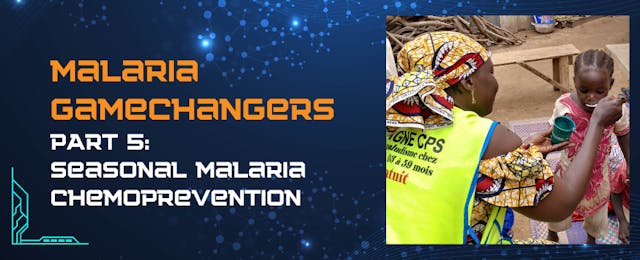

Part 5 of our Malaria Gamechangers series (check out Episodes 1-4) highlights seasonal malaria chemoprevention (SMC), a highly-effective method of protecting young children from malaria during peak malaria transmission season. SMC involves giving children, ages 3 months to 5 years, a monthly course of safe and effective anti-malarial drugs (a combination of sulfadoxine-pyrimethamine and amodiaquine) during the 4-month rainy season when transmission spikes. The goal is to treat any existing infections and maintain protective drug concentrations in the blood throughout the peak period. In clinical trials, it has been found to prevent up to 75% of malaria cases in children under five.
Since receiving WHO recommendation in 2012, SMC has scaled up rapidly across Africa’s Sahel region and West Africa – regions where most malaria cases occur during the 4-month rainy season. SMC campaigns reached nearly 45 million children in 2021, compared to approximately 170,000 in 2012.
United to Beat Malaria’s Jonathan Kidwell interviewed George Jagoe, Executive Vice President of Access and Product Management at Medicines for Malaria Venture (MMV), at the 2022 American Society of Tropical Medicine and Hygiene Annual Meeting in Seattle. You can watch the film and read the full interview below.
Mr. Kidwell: George, why is seasonal malaria chemoprevention [SMC] a gamechanger in the fight against malaria?
Mr. Jagoe: [SMC] is a game changer because for a long time we didn’t believe necessarily there was a way to use mass prevention of using medicines to protect children. That changed about ten years ago; you’ve seen this particularly in West Africa. There are now literally over 40 million kids per year who are taking a seasonal course of medicine, so four months out of the year, that protects them, at a very high level of safety, from being infected with malaria. And we think this is a remarkable thing because it adds one more tool to the way to save lives and and slow down the burden of malaria on young children.
Mr. Kidwell: Where is [SMC] being piloted?
Mr. Jagoe: So it began in a couple of countries in West Africa about 2010, 11, 12. And the results were so spectacular, the WHO gave it a full green light. Since then, there’s almost – not quite 15 – 13 countries regularly deploying [SMC] in the Sahel region of West Africa.
What’s exciting now is that there are countries … in East Africa – Uganda, Mozambique – that are also looking at using chemo-prevention for large swaths of their young children population.
Mr. Kidwell: What is the long-term goal for [SMC] and what are the potential roadblocks to achieving that goal?
Mr. Jagoe: Chemo-prevention today, whether it’s in children or for pregnant women, it’s using some old drugs, drugs that frankly aren’t even fit for purpose for treating an acute case of malaria; but they work well enough for prevention. That said, they’re at threat of being undermined by resistance.
So the long term goal is that we can bring in new drugs, which will have much better profile and a longer life before resistance could undermine them. Then you’re really talking about maybe many, many years more of being able to do chemo-prevention to a larger, expanding group of children and even teenagers and vulnerable populations. But we do need innovation in the tools that we’re using.
Stay tuned as we highlight a new Malaria Gamechanger each week throughout May!